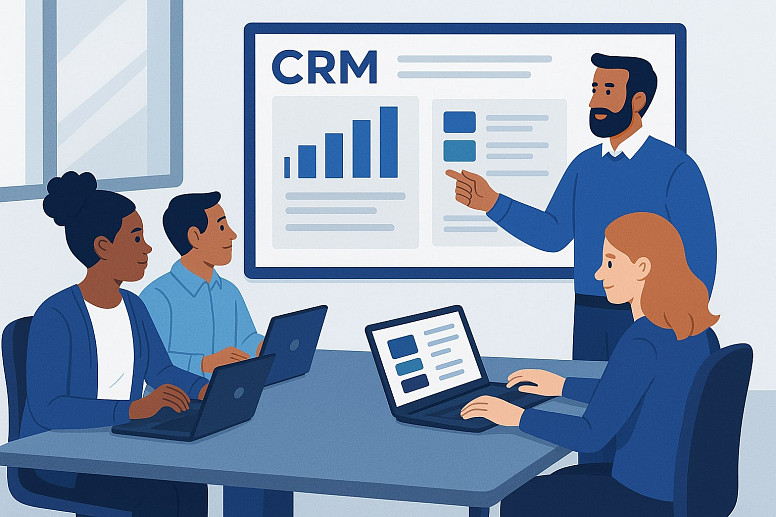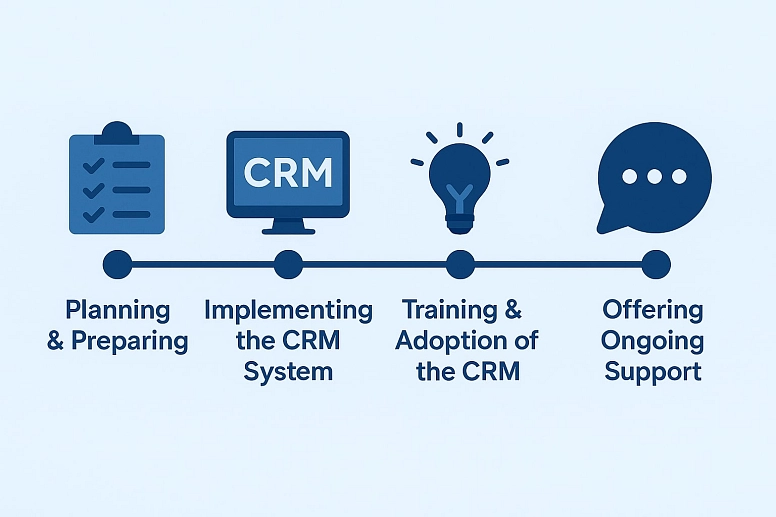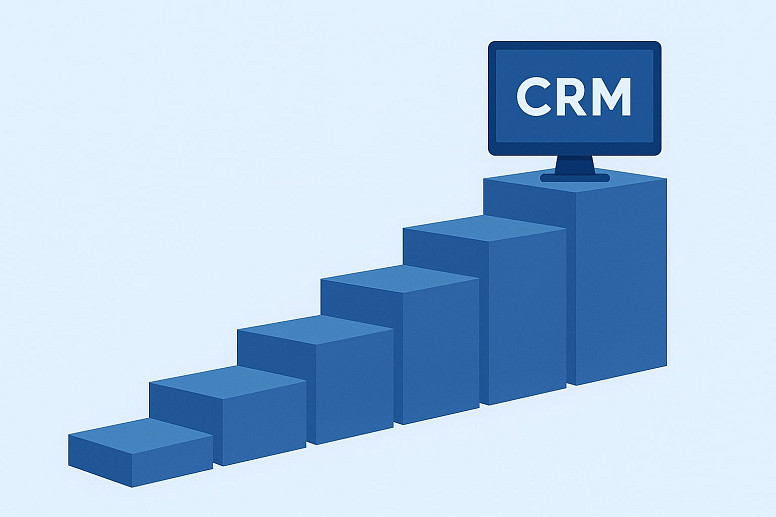CRM Onboarding & Adoption: Your Step-by-Step Guide for 2025
CRM. Just three letters. But they come with a lot of expectations. You picked one. Maybe even the best one for your business. That’s great. But here’s the catch—buying a CRM isn’t the same as using one. It’s like buying a treadmill and thinking that alone will get you in shape.
So, what happens next? Onboarding. And then—adoption. Two big steps. Can’t skip either.
First: What Is CRM Onboarding?
CRM onboarding is where the setup happens. Accounts get created. Fields are added. Emails and pipelines get connected. You configure things. Integrations go live. The CRM moves in.
But CRM onboarding is not just about flipping switches.
Your business has its own way of working. Your tools. Your habits. Your quirks. The CRM has to match that—or at least meet it halfway. Otherwise, things fall apart before they even start.
And Then: What About CRM Adoption?
This part is trickier.
CRM adoption means your team actually uses the CRM system. Not just one person. Everyone. Sales. Operations. Marketing. Even that one guy who still keeps customer notes in a paper notebook.
If they’re not using it, you’re throwing money into a black hole. High adoption? That’s when the CRM system is doing its job. Leads get tracked. Deals move. Data stays clean. Processes run smoothly.
Low adoption? You’ll see signs. Confusing fields. Tools no one opens. A help center tab collecting dust. Training that barely scratches the surface—or skips key parts of the system entirely.
How to Actually Get Your Sales Team to Use a CRM
There’s no question your sales team keeps the engine running. They bring in the deals, build the pipeline, and move things forward. So, when it’s time to shake things up with a new tool, you can’t just throw it at them and hope for the best. You need a plan. And it starts with how you bring them into the conversation.
The truth is, most people don’t like change. It’s easier to stick with what’s familiar—even if it’s messy. Switching things up means learning something new, and that can feel like a distraction. But if your goal is growth, standing still isn’t an option. Your team needs to see the upside. It’s not about forcing a shift. It’s about showing them why the shift is worth it.
Specifically, with a new CRM in play, proper CRM onboarding isn’t optional. Without CRM onboarding, the deals slow down. The process breaks. And your team? They’re stuck, unsure what to do next. You’ve got to give them the tools, the training, and the data they need. Otherwise, the CRM system sits there unused, while the old habits creep back in.
Here’s a breakdown of why CRM onboarding matters—and what it can fix—based on what we’ve seen work in real teams:
#1: Higher Adoption Rate:
A solid CRM onboarding plan shows your sales team how the CRM system actually helps them—fewer clicks, faster updates, cleaner pipelines, and better access to data. When they see how it makes their day smoother, they’re far more likely to use it. That’s how you boost adoption without forcing it.
#2: More Efficiency:
When you take the time to create a good CRM onboarding process for your sales team, you can be sure that they will understand the CRM system completely and know how to make the best out of it. Since they will know how it works, they won’t lose time searching for a feature or anything else. Their time will be used to generate revenue by closing more deals.
#3: Better Collaboration:
One of the main advantages of using a CRM system is that it also helps improve collaboration. And this is especially important for salespeople. After all, they need to access all the information about a client to close the deal. With a CRM tool, they can access all the data from just one place—but only if CRM onboarding sets them up properly from the start.
#4: Better Efficiency & Productivity:
Training your sales reps on the CRM system isn’t just about button-clicking. It’s about giving them the know-how to use the right features at the right time. CRM onboarding makes that possible. When they understand how everything works, they waste less time figuring things out—and spend more time selling. That means more deals on the board and more revenue in the door.
#5: Improved Customer Service:
With proper CRM onboarding and training, your team can quickly pull up everything they need to know about a customer. No scrambling. No second-guessing. That makes it easier to respond fast, offer help that actually fits the situation, and keep the conversation personal. Stronger relationships follow—and with them, more loyalty, happier customers, and fewer churn risks.
#6: Better Quality of Data:
When you get a CRM system that salespeople actually use, you’ll also get data with better quality. After all, your salespeople will be more consistent when adding data to the CRM (data migration). That consistency starts with great CRM onboarding. And we don’t need to tell you how important this is.
#7: Give Your Business a Competitive Edge:
When your sales team knows how to use the CRM well, they spot opportunities faster, adapt quicker, and close deals with less friction. Training gives them that edge. It’s not just about using a tool—it’s about staying sharp. And when your team runs smoother than the others, you’re not just keeping up. You’re pulling ahead.
Custom CRM Onboarding: 4 Phases
Phase #1: Planning & Preparing:
Before anything gets rolled out, you need to get clear on what your business actually needs and what you’re trying to achieve. Once you’ve chosen the right CRM, it’s time to map out the rollout. That means setting goals, picking the right metrics to track progress, and creating a timeline with real deadlines. And don’t forget the data transfer—plan it well to avoid delays or messy downtime.This is the foundation of your CRM onboarding.
Phase #2: Implementing the CRM System:
While all CRMs are different, setting them up is a step that you need to take now. You should begin by customizing and configuring the CRM system according to your existing workflows. Make sure that you involve your teams to ensure that all their needs are met with the CRM. After all, good CRM systems have plenty of integrations and automation tools that you can use.
As soon as you have all the configurations ready, you’ll need to migrate the data and then carefully check it for consistency and accuracy. This means that you need to test it deeply to make sure that all its features are working. These implementation steps are a crucial part of CRM onboarding.
Phase #3: Training & Adoption of the CRM:
Once the CRM is up and running, your next move is to train the team. And not just with a single video or manual. Use a mix—docs, webinars, live workshops, quick how-tos. Different people learn in different ways, so cover your bases and make sure they know where to find the right data when they need it.
While you’re at it, keep the lines open. Ask for feedback. Encourage questions. The goal here isn’t just to teach the tool—it’s to make sure everyone feels comfortable using it day to day and knows how to work with the data it provides.
Phase #4: Offering Ongoing Support:
The connection between your sales team and the CRM needs to stay strong. That means giving them a system they can count on—and making sure help is always within reach. Set up support channels, keep resources easy to access, and be ready to jump in when questions come up. It’s not a one-and-done. It’s ongoing. Great CRM onboarding always includes a plan for long-term support.
6 Steps to Create an Effective CRM Onboarding Process
Even though all organizations and CRMs are different, the truth is that this step-by-step guide can help them all with an effective CRM onboarding process. So, make sure that you follow the next 6 steps.
Step #1: Choose an Easy-to-Use CRM Software:
If you want CRM onboarding to go smoothly, start by picking a CRM that’s simple to use. Many people push back on new tools—not because they don’t care, but because they don’t want extra friction. The easier the CRM feels, the quicker it becomes part of their routine.
You’ll want to think carefully here. There are plenty of options out there. Start with what your business needs. Then look at what each CRM brings to the table. Features like integrations, reporting, and analytics may sound great—but only if they truly support how your team works.
And remember: more features doesn’t always mean better. In fact, too many can slow your team down. A bloated system will only make adoption harder.
What you need is something clean. Intuitive. A tool that doesn’t get in the way, but actually fits into daily work without a learning curve that lasts forever.
Look for features like:
- Sales analytics and reporting
- Automated sales workflows
- Easy integrations
- Custom dashboards
- Multiple pipelines and deal views
- Smooth data import
- Task management for teams
- Mobile access on Android and iOS
- Performance stats by rep or team
A good example? Flowlu. It’s built to be straightforward right out of the gate. With custom dashboards, automation, easy pipeline management, and simple integrations, it gives your team what they need—without the overload. That ease of use gives CRM onboarding a major head start.
Step #2: Show the CRM Advantages:
One of the things that can certainly help your employees adopt the change faster is to start by showing them the huge advantages of using the CRM you chose. But you shouldn’t simply list the features. You need to show them how their work will be easier, faster, and even more motivating.
Let’s say that you still use spreadsheets in your company. In this case, your employees may see this change as difficult and coming with more work for them. In this case, you need to point them in the right direction and show them that this CRM system can help automate some of their tasks.
You should come up with a list of advantages of using a CRM system and combine it with practical examples. Some of the benefits you can show your employees include:
- Accelerate your workflow with a well-organized client information database
- Free up time for higher-value tasks by automating routine sales activities
- Increase profits by converting leads into customers faster and more efficiently
- Track your sales progress clearly with a structured sales pipeline
- Measure performance effectively through detailed sales reports and analytics
An initial presentation to show your employees these benefits might be the first step to show them how easy it is to use this new tool—and how valuable proper CRM onboarding will be.
Step #3: Hire a CRM Manager:
If you want the CRM onboarding process to run smoothly, consider bringing in a CRM manager to lead the charge. This person will be in charge of the system—making sure everything works, everyone’s on board, and nothing falls through the cracks.
Their job is to oversee the CRM system setup, support your team during onboarding, and guide adoption across departments. They’ll also build out customer profiles based on your business data and help connect the dots between sales and marketing.
In short, they keep everyone aligned and focused on one clear goal: delivering a better experience for your customers through effective CRM onboarding.
But the CRM manager has a lot more responsibilities. Some of the most important ones are:
- Updating the system and the different accounts created
- Making suggestions about new approaches to customers and clients
- Designing new or updating workflows in the CRM system
- Monitoring sales pipelines to make sure they work
- Keeping track of analytics to monitor progress
If you’re considering hiring a new CRM manager, you are probably thinking about who’s the right person for the job. The truth is that you have options. You may prefer to hire someone new, external to your organization but with experience in the area, or you may opt for offering the job to one of your employees, someone who you believe has the right mindset for the position. No matter who you pick for the job, he or she needs to be responsible, creative, experienced, personable, educated, and analytical—especially when leading the CRM onboarding process across teams.
Step #4: Train Your Employees With Guides:
When you’re aiming to make the CRM onboarding process smooth, it’s a smart move to create simple guides for your team. These can be quick how-tos, FAQs, or step-by-step walkthroughs. Having something they can turn to on their own saves time—both theirs and everyone else’s. It also gives them more confidence to explore the CRM without feeling stuck or unsure. The truth is that most employees will have the same questions. So, if they can find the answers directly in the guides you write, the better.
When writing the guides, you should consider using a folder with all the materials. These should include:
- A guide on how to use the CRM system from start to end
- A CRM tool FAQs
- A library of the different workflow templates they can use to improve their processes
- And others you may think of
Even though you may have all these materials ready to be used when you do the initial presentation of the CRM system, it’s important to also hold regular training sessions and workshops as part of ongoing CRM onboarding. These show your employees that this system is to make their lives easier, not harder. After all, up until now, they are seeing another tool they need to learn how to use, but they don’t see any real benefits for them. This is why it’s important to keep showing them how it will be great when they are using the system fully.
Step #5: Adopt a Gaming Mindset:
Sometimes, the best way to help your employees adopt a new tool and make the CRM onboarding process smooth is by using gamification. Simply put, make the process fun by transforming it into a game.
Adopting a gaming mindset means that you should try to create a fun and friendly competition between your employees to motivate them to learn the system, explore the data, and start using it faster. Remember that if you will hold a competition, you need to have a reward for the winner in the end. You may even come up with a celebration with a small ceremony for the prize delivery. This will make everyone motivated and eager to start using the CRM and its data to its fullest.
Step #6: Automate Processes:
To ensure that you have an effective CRM onboarding process, you may consider automating some of the processes and then showing them to the respective teams. Just take the sales team, for example. Your sales representatives usually spend a lot of time with their spreadsheets instead of closing deals. Well, with a CRM system, this can be inverted. All it takes is showing them that the CRM can handle the data automatically. With those processes running in the background, they free up time for what really matters—like closing deals and focusing on high-value work.
9 Best Practices & Tips for Increasing CRM Adoption
#1: Clear Communication:
There’s no question that clear communication is key to a successful CRM onboarding process and adoption. Set up open, easy-to-use channels, and make sure stakeholders know they can speak up, ask questions, and share feedback anytime. You may also consider setting up regular conference calls and meetings if you believe they are necessary.
#2: Keep Monitoring & Adjusting:
When you continue monitoring and adjusting the onboarding and СRM adoption plan, the user will be more responsive to what you say. Be ready to make all the adjustments that are needed in a timely way.
#3: Ask for Feedback from Users:
You shouldn’t wait for the CRM users to come to you. You should proactively look for their feedback throughout the onboarding and CRM adoption processes. After all, they can help identify areas where extra training is needed, for example.
To get their feedback, you might carry out focus group discussions or regular surveys.
#4: Provide Different Types of Training:
As we already mentioned above, you should provide different types of training depending on the tasks, features, and the users as well. You should make sure that your training materials accommodate all learning styles and that they are all clear and easily accessible. You may prefer the training to be more personalized or in groups at first, and then allow each user to evolve at their own pace. This flexibility can help boost CRM adoption across different user types.
#5: Take a Closer Look at Integrations:
Integrations are an important part of using a CRM. The truth is that you probably already use tools that you want to keep using, even though you’re adopting a new CRM in your business. And this is perfectly fine as long as the CRM that you choose allows integration with these tools. Besides allowing them, you want to make sure that they are working well.
Keep in mind that integrations should also make the CRM adoption easier by streamlining the workflows.
#6: Make Use of CRM Automation Features:
A good way to captivate users to adopt the CRM is by showing them how automation can save them a lot of time and energy. Highlighting these efficiencies early on can drive faster CRM adoption.
#7: Ensure Real-Time Collaboration:
The best CRM systems, like Flowlu, already have their own app that users can access no matter where they are. This app is perfect for collaboration, but it can also be a huge help for other things such as getting notifications, accessing data, and keeping track of tasks.
#8: Share Success Stories:
If there is something that can help motivate users to adopt a new CRM, it is listening to a success story that is inspirational. The reality is that there are always users who don’t like changes and are less receptive to them. However, you can help them by sharing success stories that highlight the benefits of CRM adoption.
#9: Make CRM Adoption Enjoyable:
If you’re noticing that many users are holding back and aren’t liking the idea of using a new CRM system, you may turn its adoption into a fun game with a competition in the middle. You may give a reward to users who reach a specific milestone, for example. As soon as some users join the game, others will certainly follow—and so will the CRM adoption rate.
Bottom Line
If you’ve decided it’s time to roll out a new CRM, you’re at the start of a big (and important) step. It can feel a bit overwhelming at first. That’s normal. You want each department to actually use the tool—not just have it sitting there. That’s why building solid CRM onboarding and adoption plans is key.
If you’re after a CRM that’s easy to get started with and built to encourage adoption from day one, Flowlu’s worth a look. It’s flexible, integrates easily with your current tools, and has an interface that teams can actually enjoy using—making the switch feel less like a hassle and more like a win.
It depends. Every company’s different. The time it takes usually comes down to how complex your setup is, how comfortable your team is with new tools, and how solid your CRM onboarding plan is. On average, expect around 2 to 3 months to get fully up and running.
You know your team best. Some folks prefer hands-on workshops. Others like quick video tutorials or clickable walkthroughs. Luckily, you’ve got options—webinars, team meetings, knowledge base articles, live Q&A sessions, step-by-step guides, and more. Mix and match based on what works for your people—and make them part of your CRM onboarding toolkit.
Yes, Flowlu is built to make the CRM onboarding process feel simple. Even if your team’s new to CRM tools, the interface is clean, the learning curve is short, and there are built-in guides to help along the way. You can customize workflows, create templates, assign roles, and automate routine tasks—all without needing a tech expert to set it up. Most teams find they’re up and running quickly, with minimal hand-holding.

















